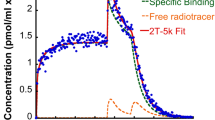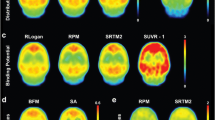Abstract
In practical positron emission tomography (PET) diagnosis, a shortened protocol is preferred for patients with brain disorders. In this study, the applicability of a shortened protocol as an alternative to the 90-min PET scan with [11C]SA4503 for quantitative sigma1 receptor measurement was investigated. Tissue time-activity curves of 288 regions of interest in the brain from 32 [11C]SA4503-PET scans of 16 healthy subjects prior to and following administration of a selective serotonin reuptake inhibitor (fluvoxamine or paroxetine) were applied to two algorithms of quantitative analysis; binding potential (BP) was derived from compartmental analysis based on nonlinear estimation, and total distribution volume (tDV) was derived from Logan plot analysis. As a result, although both BP and tDV tended to be underestimated by the shortened method, the estimates from the shortened protocol had good linear relationships with those of the full-length protocol. In conclusion, if approximately 10% differences in the estimated results are acceptable for a specific purpose, then a 60-min measurement protocol is capable of providing reliable results.
Similar content being viewed by others
References
Kawamura K, Ishiwata K, Tajima H, Ishii S, Matsuno K, Homma Y, et al. In vivo evaluation of [11C]SA4503 as a PET ligand for mapping CNS sigma1 receptors. Nucl Med Biol 2000;27:255–261.
Sakata M, Kimura Y, Naganawa M, Oda K, Ishii K, Chihara K, et al. Mapping of human cerebral sigma1 receptors using positron emission tomography and [11C]SA4503. Neuroimage 2007;35:1–8.
Mishina M, Ishiwata K, Ishii K, Kitamura S, Kimura Y, Kawamura K, et al. Function of sigma1 receptors in Parkinson’s disease. Acta Neurol Scand 2005;112:103–107.
Ishiwata K, Oda K, Sakata M, Kimura Y, Kawamura K, Oda K, et al. A feasible study of [11C]SA4503-PET for evaluating sigma1 receptor occupancy by neuroleptics: the binding of haloperidol to sigma1 and dopamine D2-like receptors. Ann Nucl Med 2006;20:569–573.
Watabe H, Ikoma Y, Kimura Y, Naganawa M, Shidahara M. PET kinetic analysis: compartmental model. Ann Nucl Med 2006;20:583–588.
Logan J, Fower JS, Volkow ND, Wolf AP, Dewey SL, Schlyer DJ, et al. Graphical analysis of reversible radioligand binding from time-activity measurements applied to [N-11C-methyl]-(−)-cocaine PET studies in human subjects. J Cereb Blood Flow Metab 1990;10:740–747.
Kimura Y, Naganawa M, Sakata M, Ishikawa M, Mishina M, Oda K, et al. Distribution volume as an alternative to the binding potential for sigma1 receptor imaging, Ann Nucl Med 2007;21:533–535.
Ishikawa M, Ishiwata K, Ishii K, Kimura Y, Sakata M, Naganawa M, et al. High occupancy of sigma-1 receptors in the human brain after single oral administration of fluvoxamine: a PET study using [11C]SA4503. Biol Psychiatry 2007;62:878–883.
Author information
Authors and Affiliations
Corresponding author
Rights and permissions
About this article
Cite this article
Sakata, M., Kimura, Y., Naganawa, M. et al. Shortened protocol in practical [11C]SA4503-PET studies for sigma1 receptor quantification. Ann Nucl Med 22, 143–146 (2008). https://doi.org/10.1007/s12149-007-0088-x
Received:
Accepted:
Published:
Issue Date:
DOI: https://doi.org/10.1007/s12149-007-0088-x




